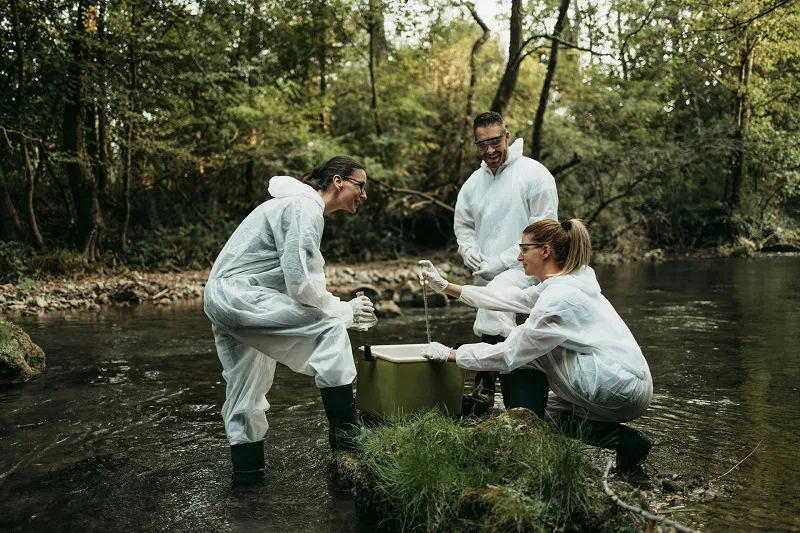Bacteria make up the great bulk of the approximately one trillion species of microbes that exist on Earth.
One cell makes up a bacterium. Unlike large animals that leave distinct marks in the geological record that grateful palaeontologists can examine millions of years later, they lack bones.
Because of this, scientists have had an extremely difficult time creating a timeline of their early evolution. However, machine learning has allowed us to fill in a lot of the blanks. Our recent study, which was released in Science today, also shows that some bacteria acquired the capacity to use oxygen some 2.4 billion years before the planet became oxygen-saturated.
A monumental event in Earth’s history
About 4.5 billion years ago, the Moon formed. Violently. A Mars-size object collided with Earth, turning its surface into molten rock. If life existed before this cataclysm, it was probably destroyed.
Then single-celled microorganisms, the present forebears of all living things, emerged. These bacteria were the only life on Earth throughout the first 80% of life’s history.
Evolutionary biologist Theodosius Dobzhansky famously stated in 1973 that nothing in biology makes sense except in the context of evolution. However, how did life evolve during Earth’s early history?
Comparing DNA sequences from the wonderful diversity of life we see today can tell us how different groups relate to each other. For instance, we humans are more closely related to mushrooms than we are to apple trees. Likewise, such comparisons can tell us how different groups of bacteria are related to each other.
But comparison of DNA sequences can only take us so far. DNA comparisons do not say when in Earth’s history evolutionary events took place. At one point in time, an organism reproduced two offspring. One of them gave rise to mushrooms, the other to humans (and lots of other species too). But when exactly did that organism live? How many years ago?
One thing geology teaches us about is the existence of another monumental event in the history of Earth, 2.4 billion years ago. At that time, the atmosphere of the Earth changed dramatically. A group of bacteria called the cyanobacteria invented a trick that would alter the story of life forever: photosynthesis.
Harvesting energy from the sun powered their cells. But it also generated an inconvenient waste product, oxygen gas.
Over the course of millions of years, oxygen in the atmosphere slowly accumulated. Before this “Great Oxidation Event”, Earth contained almost no oxygen, so life was not ready for it. In fact, to uninitiated bacteria, oxygen is a poisonous gas, and so its release into the atmosphere probably caused a mass extinction. The surviving bacteria either evolved to use oxygen, or retreated into the recesses of the planet where it doesn’t penetrate.
The bacterial tree of life
The Great Oxidation Event is especially interesting for us not only because of its impact in the history of life, but also because it can be given a clear date. We know it happened around 2.4 billion years ago – and we also know most bacteria that adapted to oxygen had to live after this event. We used this information to layer on dates to the bacterial tree of life.
We started by training an artificial intelligence (AI) model to predict whether a bacteria lives with oxygen or not from the genes it has. Many bacteria we see today use oxygen, such as cyanobacteria and others that live in the ocean. But many do not, such as the bacteria that live in our gut.
As far as machine learning tasks go, this one was quite straightforward. The chemical power of oxygen markedly changes a bacteria’s genome because a cell’s metabolism becomes organised around oxygen use, and so there are many clues in the data.
We then applied our machine learning models to predict which bacteria used oxygen in the past. This was possible because modern techniques allow us to estimate not only how the species we see today are related, but also which genes each ancestor carried in its genome.
A surprising twist
By using the planet-wide geological event of the Great Oxidation Event effectively as a “fossil” calibration point, our approach produced a detailed timeline of bacterial evolution.
Combining results from geology, paleontology, phylogenetics and machine learning, we were able to refine the timing of bacterial evolution significantly.
Another unexpected finding from our research was that there were bacterial lineages that could use oxygen about 900 million years prior to the Great Oxidation Event. This implies that even in situations where atmospheric oxygen was limited, these bacteria developed the capacity to use oxygen.
Interestingly, our results showed that oxygen utilization was really evolved by cyanobacteria prior to photosynthesis.
This paradigm shows how life’s capacities changed in response to Earth’s shifting conditions, which also reshapes our view of the evolutionary history of microorganisms.












